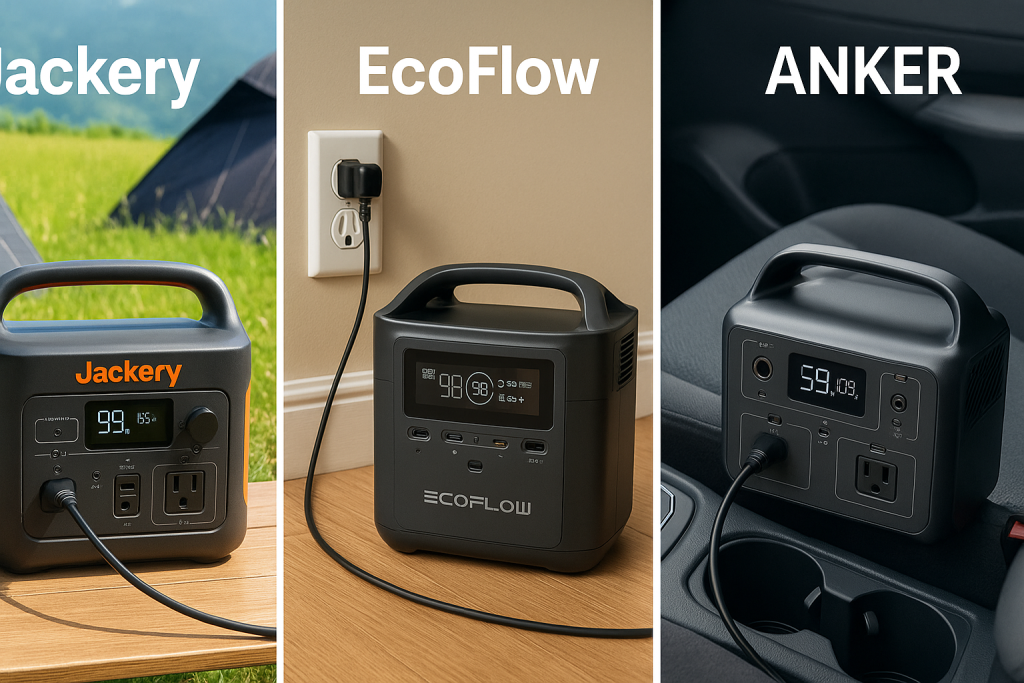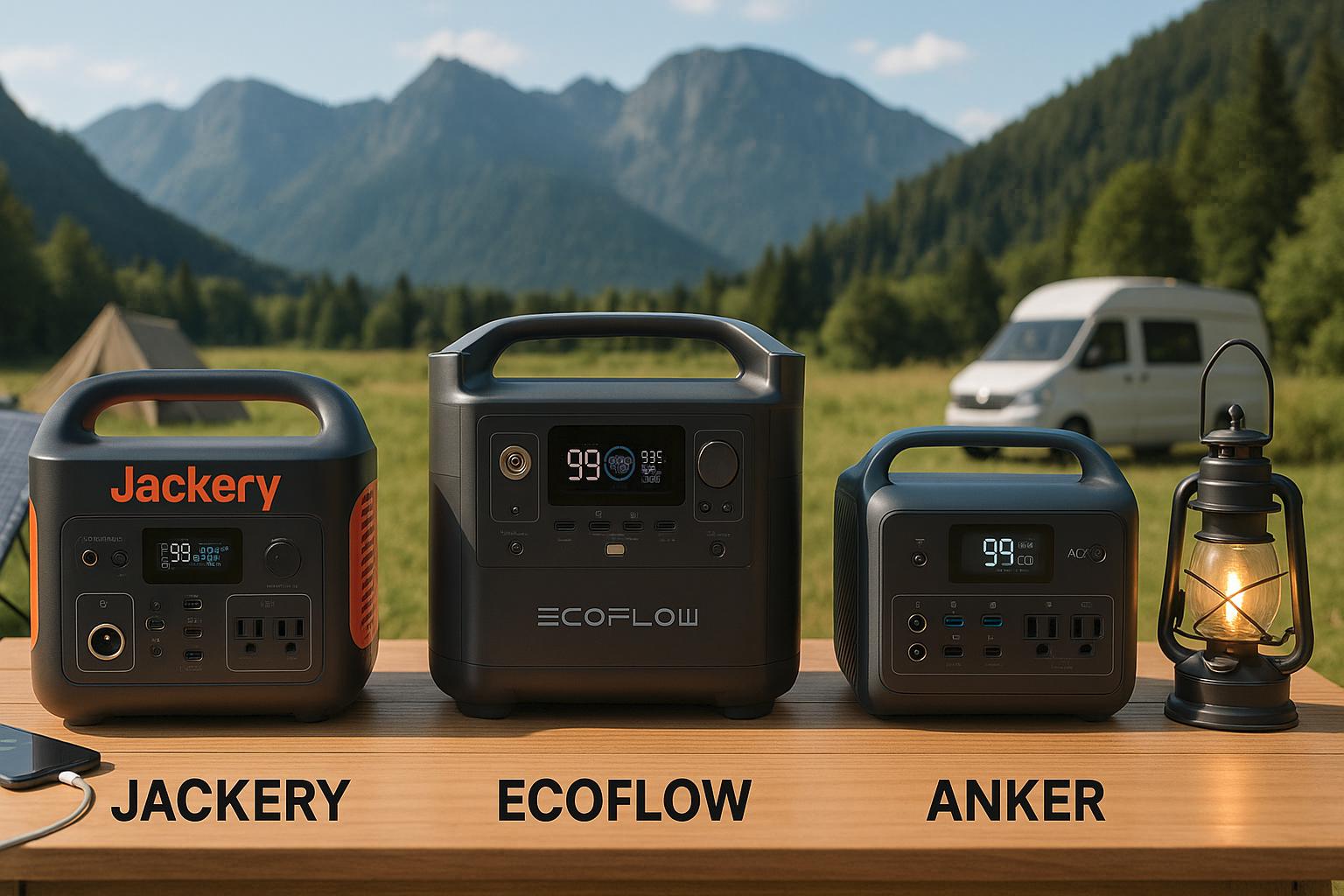Jackery vs. EcoFlow vs. Anker: The Ultimate Comparison of Portable Power Stations in 2025
The Rise of Portable Power Stations
In recent years, portable power stations have gone from being a luxury gadget for tech enthusiasts to a crucial tool for everyday users. Whether you’re a weekend camper, remote worker, homeowner preparing for outages, or part of the growing off-grid movement, these versatile power units have become indispensable.
The growing need for sustainable energy alternatives and increased occurrences of blackouts globally have fueled this demand. Coupled with innovations in battery technology and greater solar charging capabilities, portable power stations are evolving fast — offering reliable, renewable power without the noise or fumes of traditional gas generators.
According to recent forecasts, the global portable power station market is expected to grow at a compound annual growth rate (CAGR) of 8.7% from 2025 to 2032, reaching a projected $1.26 billion by 2032. This impressive growth is driven not only by the consumer demand for energy independence but also by advancements in battery chemistry, mobile app integration, and solar technology.
Why Compare Jackery, EcoFlow, and Anker?
If you’re in the market for a portable power station in 2025, three names consistently top the charts:
- Jackery: A trailblazer known for its rock-solid reliability and strong solar ecosystem.
- EcoFlow: A performance leader pushing the boundaries of fast charging and expandability.
- Anker: A value-driven contender offering smart, compact, and affordable alternatives.
Each brand caters to different needs, budgets, and use cases — and with so many overlapping specs and marketing claims, it can be overwhelming to make the right choice.
That’s where this guide comes in.
We’ll break down and compare capacity, charging speed, portability, battery type, safety, and price, giving you the clarity to confidently invest in the right portable power station for your lifestyle.
Key Features to Consider When Choosing a Portable Power Station
Before we dive into the brand breakdown, it’s important to understand the key specs that will directly affect your experience.
A. Capacity (Watt-hours) and Output Power (Watts)
- Capacity (Wh) defines how long a power station can run your devices. Think of it as the size of the fuel tank.
- Output Power (W) determines what kind of devices you can run — from lights to refrigerators.
Typical Use Cases by Capacity:
- Under 300Wh: Ideal for phones, tablets, cameras, and laptops.
- 300–600Wh: Suitable for short trips, medical devices like CPAPs, and portable fridges.
- 600Wh+: Great for extended trips, RV use, emergency home power, or power tools.
Output Power Tiers:
- 200–500W: For small electronics and lights.
- 1,000W+: For microwaves, power drills, coffee makers, and even electric grills.
B. Charging Options
Modern power stations offer multiple ways to recharge:
- AC Wall Charging: Fastest and most convenient; top-tier models like the EcoFlow Delta Pro can go from 0% to 80% in under 60 minutes.
- Solar Charging: Essential for off-grid use. Look for units with high solar input compatibility.
- Car Charging (12V DC): Handy for road trips, though usually the slowest method.
C. Portability and Weight
Weight and form factor vary widely:
- Under 20 lbs: Ideal for hiking, small loads, and true portability.
- 20–60 lbs: Manageable for most users, often with handles or wheels.
- 100+ lbs: Reserved for home backup systems. These may require two people to move.
D. Battery Chemistry and Lifespan
- Lithium-ion (Li-ion): Lighter and cheaper, but usually lasts around 500 cycles before capacity fades.
- LiFePO4 (LFP): Heavier but far more durable — over 3,000–6,000 cycles. Also safer due to thermal stability.
E. Built-in Safety Features
Good power stations protect both the device and the user:
- Overload protection
- Temperature control
- Short-circuit prevention
- Pure sine wave inverter: Ensures compatibility with sensitive electronics like CPAPs, laptops, and cameras.
F. Price and Value
Your budget will determine your feature set:
- Budget Tier ($200–$500): Basic power stations for light-duty use.
- Mid-Range ($500–$1,500): Balanced performance with more ports, higher capacity, and faster charging.
- Premium Tier ($1,500+): Whole-home solutions, expandable batteries, and advanced app integration.
Brand Deep Dive: Strengths and Weaknesses
A. Jackery – The Reliable Pioneer
Founded in 2012, Jackery carved out its space by creating intuitive solar-compatible generators for adventurers. Its orange-accented power stations are a familiar sight among RVers and campers.
Popular Models:
- Jackery Explorer 300 – 293Wh, 300W output; ultra-portable.
- Jackery Explorer 1000 – 1070Wh, 1500W output; perfect for mid-sized loads.
Strengths:
- Seamless solar panel ecosystem.
- Rugged and dependable in the field.
- Simplified interface — great for beginners.
Weaknesses:
- Charging speed lags behind EcoFlow.
- Fewer modular or expandable options.
B. EcoFlow – The Fast-Charging Innovator
EcoFlow has become synonymous with innovation. Their X-Stream fast charging tech allows models like the Delta 2 to fully charge in under 90 minutes — making them ideal for emergency preparedness.
Popular Models:
- EcoFlow River 2 Pro – 768Wh, 800W output; fast and portable.
- EcoFlow Delta Pro – 3.6kWh (expandable to 25kWh), 3600W output; home backup ready.
Strengths:
- Fastest charging in the industry.
- Modular expandability (Delta Pro).
- Smart app with remote monitoring and power usage stats.
Weaknesses:
- Higher price tag.
- Heavier than comparable models.
C. Anker – The Budget-Friendly Contender
Anker’s entry into the portable power space is more recent, but they’ve earned a loyal following. Known for dependable phone chargers and cables, Anker brings similar reliability to power stations — with a focus on affordability.
Popular Models:
- Anker 521 PowerHouse – 256Wh, 300W; compact and great for basic use.
- Anker SOLIX C1000 – 1056Wh, 1800W; mid-range powerhouse with fast recharge.
Strengths:
- Competitive pricing.
- Lightweight and travel-friendly.
- Strong brand trust in consumer electronics.
Weaknesses:
- Fewer high-end features.
- Lower max capacity compared to EcoFlow.

Head-to-Head Comparison Table
| Feature | Jackery Explorer 1000 | EcoFlow Delta 2 | Anker SOLIX C1000 |
|---|---|---|---|
| Capacity | 1070Wh | 1024Wh | 1056Wh |
| Output Power | 1500W | 1800W | 1800W |
| Charging Time | 5.5 hrs (AC) | 1.3 hrs (AC) | 1.4 hrs (AC) |
| Weight | 32 lbs | 27 lbs | 28.5 lbs |
| Battery Type | LiFePO4 (4000 cycles) | LiFePO4 (3000 cycles) | LiFePO4 (3000 cycles) |
| Price (2025 est.) | $999 | $999 | $999 |
Quick Verdicts:
- 🥇 Fastest Charging: EcoFlow Delta 2
- ☀️ Best for Solar Use: Jackery Explorer 1000
- 💸 Best Budget Performer: Anker SOLIX C1000
Environmental Impact and Sustainability
One of the biggest perks of portable power stations over gas generators is their eco-friendliness.
- All three brands now use LiFePO4 batteries, which last longer and are safer for the environment.
- EcoFlow takes sustainability further with its high-watt solar integration and scalable storage that can reduce household reliance on fossil fuels.
- Jackery and Anker offer solar panels, though not quite at the efficiency or scale of EcoFlow’s options.
User Experience and Customer Support
- EcoFlow leads in software, offering a top-tier mobile app with smart energy tracking, OTA updates, and remote controls.
- Jackery wins in ease-of-use, thanks to minimalist interfaces and excellent build quality.
- Anker has earned praise for helpful, responsive customer service and strong warranties — crucial for first-time buyers.
Final Recommendations
Here’s how to decide which brand is right for you:
| Need | Best Pick |
|---|---|
| Overall Performance | EcoFlow Delta Pro |
| Best for Travel/Camping | Jackery Explorer 300 |
| Most Budget-Friendly | Anker 521 PowerHouse |
| Fastest Charging | EcoFlow Delta 2 |
| Best for Solar Use | Jackery (Explorer Series) |
Future Trends to Watch
Looking ahead, expect exciting innovations such as:
- Solid-state batteries (e.g., Yoshino Power)
- Hydrogen fuel cell generators
- Smart home integration with IoT ecosystems

